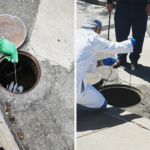Why we should seriously consider vaccinating wild birds to control bird flu
By Lynn C. Klotz | May 14, 2025
 Birds that congregate in large groups, like these snow geese, are particularly susceptible to bird flu. Credit: Steve Droter/Chesapeake Bay Program
Birds that congregate in large groups, like these snow geese, are particularly susceptible to bird flu. Credit: Steve Droter/Chesapeake Bay Program
Avian H5N1 took a big leap about four years ago. Previously the virus, first detected in the mid-1990s, would tear through domesticated poultry, killing off flocks in days. It occasionally jumped to wild birds, but it never managed to spread very far for very long. That changed in 2021 to 2022. Avian influenza or “bird flu” had long been fairly innocuous in wild birds, but the latest strain left birds severely stricken with neurological or other symptoms. Wild birds began dying in large numbers from it. But before they did, some were able to spread it to other regions where they infected other wild and domestic animals.
H5N1 has affected some 166 million commercial birds so far. Finding one sick bird means a farmer must cull the entire flock. And even if chickens are kept separate from wild birds, farmers can carry infected droppings into coops on their boots or other ways. Bird flu has now spread to dairy farms and led to scores of human infections. Far from dying out, H5N1 appears likely to pose a long-term health and economic threat.
Many countries already vaccinate poultry against bird flu. It’s been an effective strategy, but it’s not free from controversy. The United States has eschewed the practice over concerns that vaccinated birds might be able to spread the disease while themselves surviving an infection. Some countries restrict imports of vaccinated birds because of this risk. Facing the longest bird flu outbreak in US history, though, the Trump administration is considering inoculating flocks.
But by now bird flu is out of the barn, so to speak. It’s infected nearly 500 species of wild birds and mammals ranging from foxes to zoo tigers. It’s time to consider another means of stopping its spread: vaccinating wild birds and, perhaps, other wildlife. By doing so, we will rescue large numbers of animals from a painful death, slow the transmission of infections, and reduce the probability of a pandemic in humans. These outcomes provide reason enough to vaccinate wildlife.
Rabies: a precedent. Conceptually, a program to vaccinate wild birds wouldn’t be an entirely novel undertaking. Vaccinating wild animals was worked out for rabies many years ago. The Cornell University College of Veterinary Medicine Wildlife Health Lab has a good description of how this is carried out. When raccoons, coyotes, foxes and other animals tear into bait laced with a vaccine, the vaccine activates an immune response. The technique has eliminated rabies in coyotes and some species of fox. The US Department of Agriculture baits Eastern states using planes and other means to control rabies in raccoons.
Rabies kills some 60,000 people globally each year, although in some countries, like the United States, deaths are very rare. Rabies vectors like bats can also infect livestock. By reducing the spread of rabies among wildlife, vaccines help protect people, too. The same principles could help control transmission of H5N1 among birds and thereby help control outbreaks that affect people.
Not only would vaccination of wild birds, other wildlife, some pets, and commercial poultry likely help mitigate the risk of a bird flu pandemic, but it would be economically beneficial to farmers and others, including vaccine makers. There is a sizable market for bird flu vaccines (about $1 billion per year by my calculations, just for vaccines for the US cat population, which is highly susceptible to H5N1). And along with vaccines, companies would likely be able to sell supplies and equipment to scientific experts who have responsibilities for the well-being of animal populations.
How to vaccinate wild birds. Birds like snow geese, which congregate in large numbers, are ideal targets for mass vaccination. They breed during the summers in the arctic and fly south to the United States and as far as Mexico in the winter. Snow geese have turned up infected at several sites in the United States, some of the more than 400 species of wild bird to be affected by H5N1.
The World Organization for Animal Health, an intergovernmental organization, suggested in 2023 that it won’t be easy to vaccinate wild birds: “[W]ide-scale bird flu vaccination of free-ranging wild bird populations is typically considered impractical with currently available vaccination strategies,” a committee report reads. That agency and the Food and Agriculture Organization, a UN agency, called vaccinating wild birds an “urgent research priority.”
The Cornell Wildlife Health Lab points to some of the challenges facing any mass wildlife vaccination campaign: “Before a wildlife vaccine can be used in populations of wild animals, a great deal of research must be done to determine the safest and most effective vaccine, the most palatable bait formulation, and the best cost-effective distribution method [but] oral vaccination of wildlife holds great promise in limiting the public health, agricultural industry, and conservation consequences of diseases that circulate within wildlife.”
This effort will be worth it to protect wild birds, domestic poultry, and other species. Indeed, researchers have already vaccinated at least one wild bird species, the endangered California condor.
At one point in the 1980s, wild condor numbers had dropped to just over 20. The birds were captured in a bid to save them. Since then, many have been released into the wild, though they remain under close supervision. The re-wilding of the condor has been a remarkable success, and between 2010 and 2022, the wild population nearly doubled, to 350 condors. But when scientists began finding sick and dead birds during this time, they quickly grew concerned that bird flu could prove a disaster for condors and sought permission to vaccinate the birds using a poultry vaccine.
After testing the H5N1 vaccine on the closely related but abundant black vulture, scientists began vaccinating wild condors. The condor population appears stable now, but the high level of individual attention given to condors won’t be possible for large-scale vaccination campaigns of other birds. To make wild bird vaccination work, another, more efficient strategy must be developed.
Erik Karlsson, a virologists at the Pasteur Institute in Cambodia is perhaps the first to have used the term “dead birds flying” to explain why birds and seashore mammals in distant locations such as the Galapagos Islands and Antarctica become infected as sick but not-yet-dead birds bring it to new geographies. These infectious wild birds will continue to pose a threat to poultry, as they come in contact with chickens and other domestic species or as people unwittingly bring infectious material in contact with food animals.
The longer the virus jumps around in and among species, the greater the chance it will mutate and become a greater threat to people. In the United States, there have been 70 identified cases of bird flu infection in the outbreak that began in 2022; one person has died. Most of the infected people worked closely with poultry or dairy cattle. The US Centers for Disease Control and Prevention (CDC) rates the risk to the public of bird flu as low. But its leap from birds to by now dozens of mammal species is a warning that this may not always be the case. Bird flu could eventually spark a pandemic. It’s time to try a new approach to controlling it.
Editor’s note: The author would like to thank Julianne Meisner of the University of Washington’s Department of Global Health and Department of Epidemiology and the veterinarian Stephanie Norman who inspired him to consider animal vaccinations as a strategy for combatting H5N1
Together, we make the world safer.
The Bulletin elevates expert voices above the noise. But as an independent nonprofit organization, our operations depend on the support of readers like you. Help us continue to deliver quality journalism that holds leaders accountable. Your support of our work at any level is important. In return, we promise our coverage will be understandable, influential, vigilant, solution-oriented, and fair-minded. Together we can make a difference.
Keywords: H5N1, vaccines
Topics: Biosecurity















